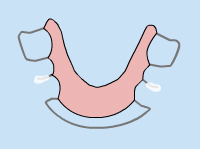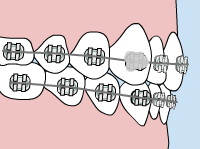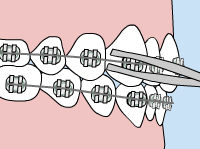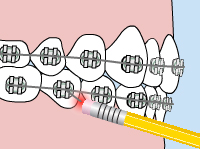What Should You Do in Case of an Orthodontic Emergency?
Orthodontic emergencies are rare. But if one occurs please call us immediately. As a general rule, you should contact us when you experience severe pain or have a painful appliance problem you can’t take care of yourself. We will schedule an appointment to resolve the problem.
Until you can come in for your appointment, you may be able to temporarily solve the problem yourself. If there is a loose piece that you can remove, put it in a plastic bag or envelope and bring it with you to your next appointment. If your braces are poking you, put soft wax on the piece that’s sticking out. If the wire has slid to one side, you can pull it back to the other side with needle-nosed pliers, sliding the wire back into the bracket or tube on the other side of the mouth.
After alleviating your discomfort, remember to call our practice to schedule a time to repair the problem. Allowing your appliance to remain damaged for an extended period of time may result in disruptions to your treatment plan.

General Soreness
Tooth soreness is common in the first few days after your braces are adjusted or when you switch to a new Invisalign aligner. This discomfort is normal, and it should get better by day 3 or 4 and usually goes away within a week. We recommend eating soft foods during this period and rinsing your mouth with warm salt-water a few times a day.
To make the salt water rinse, dissolve one teaspoonful of salt in eight ounces of warm water, and rinse your mouth vigorously. Or another alternative (and better tasting) is the Healthy Gums Rinse by The Natural Dentist. You can also rub Orabase (available in pharmacies) on the affected area to relieve discomfort. If the tenderness is severe, take Acetaminophen (Tylenol) or whatever you normally take for headache or similar pain. Taking Aspirin, Ibuprofen (Motrin, Advil) or Naproxen Sodium (Naprosyn, Anaprox) can work also, but prolonged use can actually slow down your tooth movement.
Your lips, cheeks, and tongue may also become irritated for one to two weeks as they learn a new posture and become accustomed to the surface of the braces. You can put wax on the braces to lessen this. Just break off a small piece of the wax and roll it up into a pea-sized ball and put it on whatever part of the braces that is bugging you.

Loose appliance
If your appliance is poking you, place wax on the offending part.

Loose bracket
If your bracket or band is still attached to the wire, you should leave it in place and put wax on it if needed for comfort. If the bracket or band can be removed easily, place it in an envelope and save it to bring to your appointment. Call our office as soon as you have a loose bracket to avoid delaying your treatment.

Loose wire
Using a pair of tweezers or needle-nosed pliers, try to put your wire back into place. It is okay to use a piece of floss to tie the wire into place: tie the floss around the bracket in place of the missing colored o-ring. If you cannot put the wire into a comfortable position, and covering the end with wax doesn’t help, as a last resort use a small fingernail clipper to clip the wire behind the last tooth to which it is securely fastened. If the end of the wire is still sharp place wax on it.

Poking wire
Use a cotton swab or pencil eraser to temporarily push the poking wire down so it’s flat against the tooth or place wax on it so that it is no longer poking. Then call our office to make an appointment. If you are traveling, and the above steps don’t work, you may clip it yourself. Clean and disinfect nail clippers with alcohol and very carefully snip the wire.
As your teeth move, the wire can become “longer” and poke out the back. Chewing can also cause the wire to bend and come out the very back bracket. Poky wires tend to be more common in the beginning of treatment because the initial wires are much more flexible and bend and shift more easily
Lost or Loose Ligature
The little rubber bands or thin wires that hold your brackets and archwires together are called ligatures. If you lose a rubber band, try to find it. Then, clean it and carefully put it back on with sterilized tweezers if possible. If a wire ligature comes loose, you can take it off with your tweezers. If it’s just sticking out, attempt to bend it back with a cotton swab or the eraser end of a pencil so that it doesn’t poke your lips or cheeks.
If you cannot put the wire into a comfortable position, and covering the end with wax doesn’t help, as a last resort use a small fingernail clipper to clip the wire behind the last tooth to which it is securely fastened. If the end of the wire is still sharp, place wax on it.
Lost Invisalign Aligner
If you lose an Invisalign aligner, call us right away. You may just be able to jump to the next aligner as long as it’s not too tight. If that doesn’t work, we can order you a new aligner but there may be a fee. Alternatively, If you cannot reach our office, use an aligner from your last set (which is why we recommend that patients keep their old aligners) to hold teeth in position.
